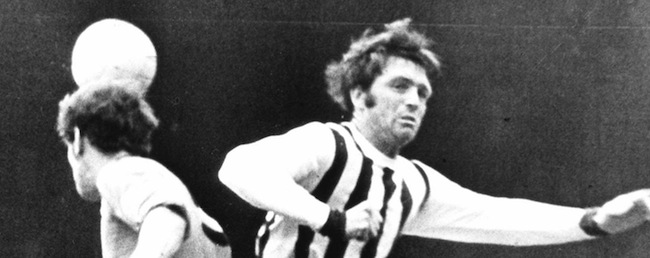WARNING: Heading a ball and playing American Football give you brain damage
DOES heading a football give you breain dmage? What about heading a person? Sam Harnett looks at research on American Footballers by Stanford researchers:
[David] Camarillo and his team have outfitted the football team with mouth guards that measure the physics of every hit. At practices, they use ultra-high-definition, slow-motion cameras to observe those collisions more closely and look for ways to prevent them. The first startling discovery of the research is how little is known about the “injury mechanism” for concussions, that is, exactly how they are caused… How hard does a hit need to be to cause a concussion outright? How many small, low-impact hits before a player begins to exhibit concussion symptoms?
And:
Camarillo says the mouth guards have already captured some startlingly hard hits, like the one that ended the season for a wide receiver. That collision registered an acceleration of 150 Gs, that’s 150 times the acceleration gravity. “Pretty serious business,” he says, “a standard boxing punch is probably between 10-20 Gs.”
That’s just acceleration in one direction. The player’s head was also spinning at 2000 degrees per second—which means his head would have rotated five and a half times in one second if it weren’t anchored to the neck.
While it has long been suspected that this kind of angular acceleration plays a role in concussions, Camarillo says no one has gathered data on it. What’s more disturbing is that angular acceleration has been completely ignored when it comes to football safety measures.
Earlier, the BBC reported:
Imaging of 32 keen amateur players revealed patterns of damage similar to that seen in patients with concussion.
There appears to be a safe cut off level of 1,000 or fewer headers a year below which no harm will be done, but the US investigators say more work is needed to confirm this.
Heading is believed to have killed the English footballer Jeff Astle. Astle, 59, who died in 2002, developed cognitive problems after years of playing for England and West Bromwich Albion.
The coroner ruled that his death resulted from a degenerative brain disease caused by heading heavy leather footballs.
And:
In addition, a classic study carried out with 69 active football players and 37 former members of the Norwegian national football team determined that 30% of the former players complained of permanent problems such as headache, dizziness, irritability, neck pain, and impaired memory(1). In addition, 35% of the active players and 32% of the former players displayed abnormal EEGs, compared with about 12% of matched control individuals. When the former players were subjected to cerebral computed tomography (CT) and a neuropsychological examination, a full one-third of the athletes were found to have central cerebral atrophy (wasting of the central region of the brain), and 81% displayed at least some signs of neuropsychological impairment. Many of these problems were believed to be linked to concussions suffered by the players during their football careers.
Dr Andrew Rutherford from the School of Psychology at Keele University noted:
“There have long been suggestions that heading the ball in football could have detrimental effects on the brain. The old-fashioned footballs that became heavier as they absorbed water certainly made this an issue of concern. However, the quality of many of the initial studies claiming to have identified ‘neuropsychological decrements’ related to football heading is poor. The initial studies also ignored the important point that footballers who head the ball frequently also compete to head the ball, and most head trauma observed in football is associated with head-to-head, or elbow-to-head contacts arising from this competition. Generally, earlier studies failed to separate any psychological consequences of these clashes from any psychological consequences due to just heading the ball. While the head injury rate in football is significant, it also should be appreciated that it is far less than is observed in other contact sports, especially rugby.”
Back to American Football: Joseph Stromberg notes:
Retired NFL players, they found, were three times more likely to die from diseases that damage brain cells, such as ALS (“Lou Gehrig’s Disease”) and Alzheimer’s, than the general population. These diseases are closely related to [Chronic traumatic encephalopathy] and may in fact represent misdiagnosed cases of CTE because the symptoms of the various neurodegenerative diseases are so similar.
Lawsuits are pending:
“The NFL, like the sport of boxing, was aware of the health risks associated with repetitive blows producing sub-concussive and concussive results and the fact that some members of the NFL player population were at significant risk of developing long-term brain damage and cognitive decline as a result,” the complaint charges.
“Despite its knowledge and controlling role in governing player conduct on and off the field, the NFL turned a blind eye to the risk and failed to warn and/or impose safety regulations governing this well-recognized health and safety problem.”
So. Should footballs and American Football come with a Government health warning?
Image: Jeff Astle, the WBA centre forward is seen (right) in the air with Dave Woodfield of Wolverhampton Wanderers. Date: 30/08/1969.
Posted: 9th, January 2013 | In: Sports Comment | TrackBack | Permalink



